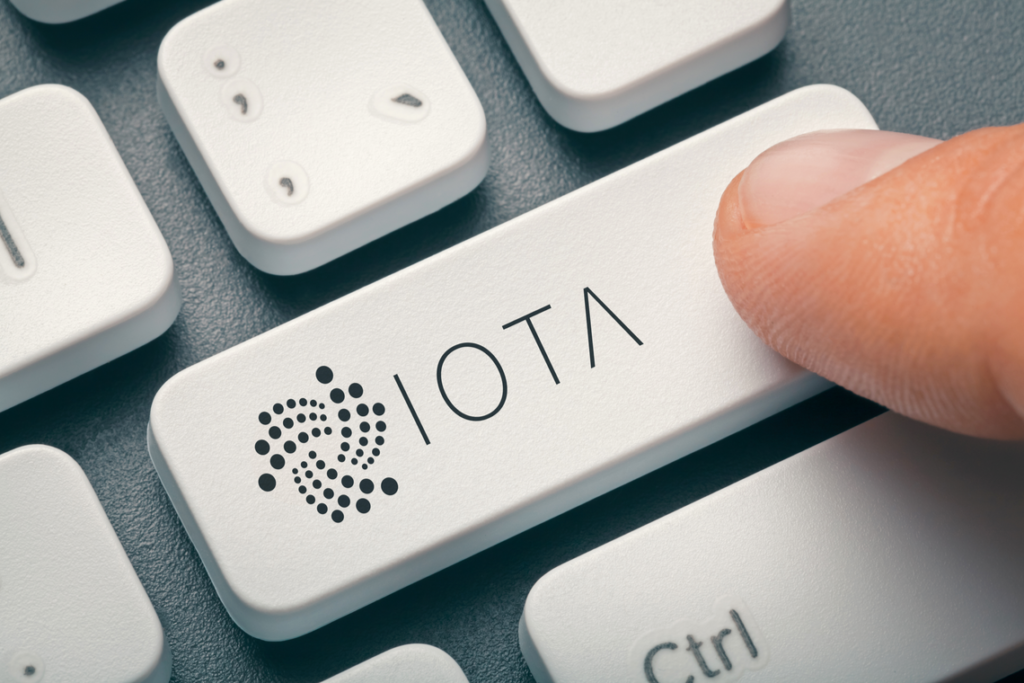The Internet of Things (IoT) and blockchain technology have long been seen as divergent future systems. Blockchain’s scalability issues, however, have made IoT data processing into a problem that has been tough to tackle.
The founders of IOTA believe that their ‘Tangle’ technology could be a possible solution, linking these two divergent fields. In an announcement released recently, the company has moved its entire platform to a fully decentralized system, allowing for increased transaction speeds, scalability, and security.
The new platform update, called Coordicide, is designed to replace the system Coordinator previously used to verify transactions. In an effort to understand this shift in one of the largest DLT platforms, BeInCrypto sat down with IOTA co-founder Dominik Schiener for a brief interview.
 BIC: Good morning, Dominik. Thanks for taking the time to help us understand this most recent announcement. Could you explain for our readers what the shift toward Coordicide is designed to accomplish?
DS: Coordicide is the most important step to date in maturing the IOTA protocol and realizing the promise of a permissionless and scalable distributed ledger technology (DLT). The ultimate goal of the project is truly limitless scalability, in which there are no protocol-related bottlenecks.
In IOTA’s infancy, it was necessary to secure the network with a temporary security mechanism which has been known as the Coordinator. The Coordinator has protected against double spend attacks and ensured transaction finality by issuing ‘milestone’ transactions at regular intervals (i.e. once a transaction is referenced by a milestone it cannot be reversed). These protective mechanisms are similar to the checkpointing system used in Bitcoin’s early years.
The Coordicide solution is a way for the network to reach a consensus without the Coordinator, while also ensuring it has the attributes of being scalable, decentralized, and secure. This is in many ways the ‘holy grail’ of DLT.
Coordicide introduces a novel means of achieving consensus. At the core of the solution is a voting mechanism – known as Shimmer, through which nodes request the opinions of other nodes in order to decide which transactions should be included in the Tangle. The Shimmer voting scheme is named after an extraordinary behavior seen in nature, where bees ‘synchronize’ their movement to defend themselves against predators.
BIC: Good morning, Dominik. Thanks for taking the time to help us understand this most recent announcement. Could you explain for our readers what the shift toward Coordicide is designed to accomplish?
DS: Coordicide is the most important step to date in maturing the IOTA protocol and realizing the promise of a permissionless and scalable distributed ledger technology (DLT). The ultimate goal of the project is truly limitless scalability, in which there are no protocol-related bottlenecks.
In IOTA’s infancy, it was necessary to secure the network with a temporary security mechanism which has been known as the Coordinator. The Coordinator has protected against double spend attacks and ensured transaction finality by issuing ‘milestone’ transactions at regular intervals (i.e. once a transaction is referenced by a milestone it cannot be reversed). These protective mechanisms are similar to the checkpointing system used in Bitcoin’s early years.
The Coordicide solution is a way for the network to reach a consensus without the Coordinator, while also ensuring it has the attributes of being scalable, decentralized, and secure. This is in many ways the ‘holy grail’ of DLT.
Coordicide introduces a novel means of achieving consensus. At the core of the solution is a voting mechanism – known as Shimmer, through which nodes request the opinions of other nodes in order to decide which transactions should be included in the Tangle. The Shimmer voting scheme is named after an extraordinary behavior seen in nature, where bees ‘synchronize’ their movement to defend themselves against predators.
 BIC: How does this new protocol provide increased scalability?
DS: Blocks in the Bitcoin blockchain must have a limited size. This limit caps the rate of transactions and restricts the network’s scalability. As an increasing number of transactions are sent on the network, miners choose to validate the transactions offering the highest fees, leading to spiraling transaction costs and lengthy waiting times.
At its core, the IOTA data layer, the Tangle, is inherently scalable. This is made possible by one simple rule: each transaction references and approves two existing transactions. Unlike in blockchain, in which there is only one site at which a transaction can be connected to the ledger, IOTA transactions can be attached anywhere and at any time.
IOTA, along with the Coordinator, is scalable and secure but it is not fully decentralized. The Coordicide proposal we are introducing today preserves the inherent scalability of the Tangle while introducing the much-desired decentralization and new ways of ensuring security.
Furthermore, without the Coordinator, it is possible to have multiple Tangles coexisting as separate domains. This lays the foundation for a dynamic sharding process known as economic clustering, through which ‘real’ unlimited scalability is enabled.
BIC: How does this new protocol provide increased scalability?
DS: Blocks in the Bitcoin blockchain must have a limited size. This limit caps the rate of transactions and restricts the network’s scalability. As an increasing number of transactions are sent on the network, miners choose to validate the transactions offering the highest fees, leading to spiraling transaction costs and lengthy waiting times.
At its core, the IOTA data layer, the Tangle, is inherently scalable. This is made possible by one simple rule: each transaction references and approves two existing transactions. Unlike in blockchain, in which there is only one site at which a transaction can be connected to the ledger, IOTA transactions can be attached anywhere and at any time.
IOTA, along with the Coordinator, is scalable and secure but it is not fully decentralized. The Coordicide proposal we are introducing today preserves the inherent scalability of the Tangle while introducing the much-desired decentralization and new ways of ensuring security.
Furthermore, without the Coordinator, it is possible to have multiple Tangles coexisting as separate domains. This lays the foundation for a dynamic sharding process known as economic clustering, through which ‘real’ unlimited scalability is enabled.
 BIC: What is the impact of Coordicide on network security?
DS: Rather than relying on the Coordinator, the network will be secured by a voting-based consensus and reputation system. A node’s vote is weighted according to the amount of reputation it holds. This secures the network even in the presence of a large number of adversaries.
Network spam will be controlled through an adaptive rate control mechanism. This intelligently varies the difficulty of the PoW per node based on different factors, such as the number of recently-issued transactions and reputation.
Coordicide introduces a decentralized form of security. The IOTA foundation will no longer need to run the Coordinator, a single point of failure.
BIC: Is decentralization critical for future DLT applications? If so, why?
DS: Yes. The true value proposition of networks like IOTA depends on their decentralized and permissionless nature. The goal of the IOTA Foundation is to establish IOTA as a global protocol for IoT and DLT applications. Adoption depends on the confidence that systems built on IOTA are free from external influence.
BIC: What are some real-world impacts of the new protocol for IOTA users?
DS: In a tangible sense, users will benefit from many of the upgrade’s strengths and features. These include faster transaction times and increased reliability. Through the introduction of auto-peering, node owners will experience significantly easier node deployment and maintenance.
In terms of less immediately tangible consequences, users will benefit from the wider adoption Coordicide facilitates. Without the Coordinator, no entity will have a special role in the network. Anyone can join the network at any time. The possible use cases for a scalable, decentralized data and value transfer network are unbounded.
BIC: What is the impact of Coordicide on network security?
DS: Rather than relying on the Coordinator, the network will be secured by a voting-based consensus and reputation system. A node’s vote is weighted according to the amount of reputation it holds. This secures the network even in the presence of a large number of adversaries.
Network spam will be controlled through an adaptive rate control mechanism. This intelligently varies the difficulty of the PoW per node based on different factors, such as the number of recently-issued transactions and reputation.
Coordicide introduces a decentralized form of security. The IOTA foundation will no longer need to run the Coordinator, a single point of failure.
BIC: Is decentralization critical for future DLT applications? If so, why?
DS: Yes. The true value proposition of networks like IOTA depends on their decentralized and permissionless nature. The goal of the IOTA Foundation is to establish IOTA as a global protocol for IoT and DLT applications. Adoption depends on the confidence that systems built on IOTA are free from external influence.
BIC: What are some real-world impacts of the new protocol for IOTA users?
DS: In a tangible sense, users will benefit from many of the upgrade’s strengths and features. These include faster transaction times and increased reliability. Through the introduction of auto-peering, node owners will experience significantly easier node deployment and maintenance.
In terms of less immediately tangible consequences, users will benefit from the wider adoption Coordicide facilitates. Without the Coordinator, no entity will have a special role in the network. Anyone can join the network at any time. The possible use cases for a scalable, decentralized data and value transfer network are unbounded.
 BIC: In terms of future changes, where do you see IOTA going from here?
DS: The Coordicide project enables much more than just a ‘better’ network. The protocol upgrade is designed with modularity at its core, meaning that each component can be independently replaced should new research reveal further improvements. Flexibility to upgrade in the future is critical to the long-term success of such rapidly advancing technology.
Without the Coordinator, it is possible to have multiple Tangles coexisting as separate domains. Each domain can implement different logic for the transactions it processes. For example, a ‘data-only’ Tangle that contains only data transactions could be separated from a Tangle that contains only value transactions. Since data transactions can never be conflicting, transactions in this Tangle could ‘confirm’ instantly.
The voting scheme also introduces the possibility of nodes voting on reliable timestamping. This allows us to start trusting timestamp values and establish a totally ordered tangle. An inability to establish an overall order has been one of the biggest drawbacks of DAG-based DLTs in relation to smart contracts.
Since the Tangle is the most generic form of DAG it will now be possible to build completely different data structures tailored to the specific needs of a use case. By implementing a different tip selection algorithm, one could build a blockchain-like structure. Structures like ‘block lattices’ could easily be emulated using a different tip selection algorithm. There is really no limit to the possibilities.
BIC: In terms of future changes, where do you see IOTA going from here?
DS: The Coordicide project enables much more than just a ‘better’ network. The protocol upgrade is designed with modularity at its core, meaning that each component can be independently replaced should new research reveal further improvements. Flexibility to upgrade in the future is critical to the long-term success of such rapidly advancing technology.
Without the Coordinator, it is possible to have multiple Tangles coexisting as separate domains. Each domain can implement different logic for the transactions it processes. For example, a ‘data-only’ Tangle that contains only data transactions could be separated from a Tangle that contains only value transactions. Since data transactions can never be conflicting, transactions in this Tangle could ‘confirm’ instantly.
The voting scheme also introduces the possibility of nodes voting on reliable timestamping. This allows us to start trusting timestamp values and establish a totally ordered tangle. An inability to establish an overall order has been one of the biggest drawbacks of DAG-based DLTs in relation to smart contracts.
Since the Tangle is the most generic form of DAG it will now be possible to build completely different data structures tailored to the specific needs of a use case. By implementing a different tip selection algorithm, one could build a blockchain-like structure. Structures like ‘block lattices’ could easily be emulated using a different tip selection algorithm. There is really no limit to the possibilities.
 BIC: Looking at the market as a whole, where do you see the greatest potential for DLT growth going forward?
DS: The Internet of Things will be a global network of connected devices, sensors, and autonomous machines communicating, relaying data, and exchanging value. The IoT will encompass a new global economy and require Distributed Ledger Technology at its core.
What are your opinions on the IOTA project and the future of the Internet of Things? Let us know your thoughts in the comments below.
BIC: Looking at the market as a whole, where do you see the greatest potential for DLT growth going forward?
DS: The Internet of Things will be a global network of connected devices, sensors, and autonomous machines communicating, relaying data, and exchanging value. The IoT will encompass a new global economy and require Distributed Ledger Technology at its core.
What are your opinions on the IOTA project and the future of the Internet of Things? Let us know your thoughts in the comments below.
Top crypto platforms in the US
Disclaimer
In adherence to the Trust Project guidelines, BeInCrypto is committed to unbiased, transparent reporting. This news article aims to provide accurate, timely information. However, readers are advised to verify facts independently and consult with a professional before making any decisions based on this content. Please note that our Terms and Conditions, Privacy Policy, and Disclaimers have been updated.

Jon Buck
With a background in science and writing, Jon's cryptophile days started in 2011 when he first heard about Bitcoin. Since then he's been learning, investing, and writing about cryptocurrencies and blockchain technology for some of the biggest publications and ICOs in the industry. After a brief stint in India, he and his family live in southern CA.
With a background in science and writing, Jon's cryptophile days started in 2011 when he first heard about Bitcoin. Since then he's been learning, investing, and writing about cryptocurrencies and blockchain technology for some of the biggest publications and ICOs in the industry. After a brief stint in India, he and his family live in southern CA.
READ FULL BIO
Sponsored
Sponsored
![IOTA Co-founder: The Future of DLT is Full Decentralization [Interview]](https://beincrypto.com/wp-content/uploads/2019/05/bic_Dominik_Schiener_IOTA.jpg.optimal.jpg)